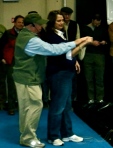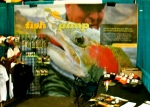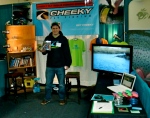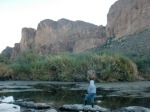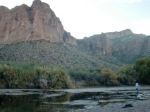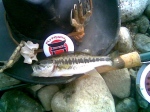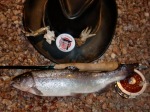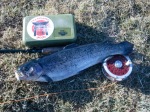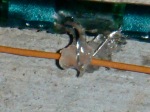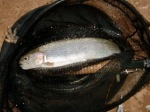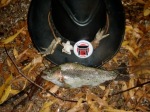RATING:
 Black Belt – 5 out of 5 – A Must See
Black Belt – 5 out of 5 – A Must See
Friday, January 21st dawned cold and with snow falling. For most people, the day foretold a cold gloomy weekend. For most that is except for those consumed by the passion called “fly-fishing”. For those driven by a passion to flick feather and hook, at the denizens of the deep, there was a warming respite from the cold, gloomy, snowy weekend; as warming as a steeping cup of coffee laced with a good Irish whisky (for medicinal purposes, of course). That warm respite was The 19th Annual Fly Fishing Expo held at the Garden State Exhibit Center in Somerset, New Jersey.
As I post this article, the snow continues to fall on the Garden State, so grab yourself a cup of java; better still grab a mug of java in the official FFD logo mug (http://www.cafepress.com/FLYFISHING_DOJO.459912522) and allow me to tell you about this magnificent exhibition.
Over the course of many years, I have attended a cornucopia of expositions, to wit: fishing expos, hunting expos, gun shows, motorcycle shows, model railroad shows and the like. In evaluating any exposition, one must inevitably critique the promoter’s choice of venue. The Fly Fishing Expo’s choice of the Garden State Exhibit Center must be commended. The venue served to enhance the pleasant experience in attending this event. The Garden State Exhibit Venter is conveniently located and has sufficient parking for the anticipated number of attendees. Further, the parking is free. The venue provided readily available food, drink and refreshment. The floor plan for the exposition allowed for steady traffic flow, accessible lectures, and two well situated fly casting pools.
The next consideration I look at in evaluating an exposition is the quality of the “featured celebrities”. The Fly Fishing Expo provided access to a great many celebrities of every genre: authors, lecturers, fly tiers, artists, guides, lodges and even a master and a living legend. In fact, there were far too many celebrities to name each and every one of them here. That said, my two favorite dignitaries were a “Master” a “Legend”; both to be named hereinafter.
Due to my schedule I was not able to attend the exposition on “opening-day”, Friday, the 21st. I awakened Saturday morning, picked up my New Jersey comrade, Sensei Bob, and we ventured out. With each mile we drove down the NJ Turnpike, our anticipation grew. We arrived at the venue and were smoothly guided through the admission process and entered the vast exhibit hall.
Sensei Bob and I were soon standing aside the casting pool witnessing a stirring Kata performance by the Master, Lefty Kreh. What, you did not know that Lefty knows Karate Kata? Frankly, I do not believe that Lefty ever studied Karate. His Kata is the Kata of fly casting. There is a plaque in our Goshin-Do Karate Dojo which reads, “Only Through Man Does Technique Become Art.” Lefty is a living embodiment of this maxim. I will not divulge Lefty’s secrets in this article; it is not my province to do so. Having said that, I am sure his books, DVD’s and seminars will help everyone that just read these words become a more efficient fly caster. http://www.leftykreh.com/
My personal “must-stop-at” booth was the Cortland booth. I have fly fished with Cortland line since I first saved and saved and saved (that is pre-credit card days for you younger readers) to be able to by their 444 line when I was a boy of 14. Since then, Cortland line is always spooled on my reel.
Due to an overwhelming popularity of the event, during our stay, crowds were impressive. Sensei Bob and I negotiated the aisles as if they were swift rapids in a stream and went about the task of perusing vendors displays, watching the various fly tiers execute their craft and chatting with the various manufacturer representatives. As to the fly tiers, they all executed their craft magnificently. There were two talented and innovated tiers that stood out in my mind on this particular day.
This is not to say that the other tiers I witnessed on Saturday were less than talented; rather, Pat and Steven’s skills and innovation with feathers and deer hair, simply struck a colorful cord in the dark recesses of my mind.
Pat Cohen:
After a few hours, Sensei Bob and I decided to take our leave.
I returned early Sunday morning. Given that it was early, the crowd was smaller than Saturday which allowed for a more direct and intimate contact with exhibitors.
My first stop was the booth of the local chapter of Project Healing Waters. I first learned of this organization, that assists our veterans in finding solace and enjoyment in the fly fishing experience, on a television episode of Curtis Fleming’s Fly Rod Chronicles. David Bucko was at the booth and gave freely of his time to further acquaint me with this organization. Take a moment and check out their website and Facebook pages (http://www.projecthealingwaters.org).
The highlight this day was stopping by the booth of a living legend. I have known his name since the first time I purchased one of his books and tied one of his innovative fly patterns. The legend is, the distinct, Dave Whitlock (www.davewhitlock.com). In Karate there is a saying, “It was my mother who bore me, but my Sensei who made me a man.” Well, since Sensei made me a man, Dave got me playing with feathers, hair and hooks – and – I am the better man for it.
I very much enjoyed all of the people I spoke with. Several of them even greatly assisted me in purchasing a few Valentine’s gifts for my charming wife. Now, since this article will post well in advance of that most heartfelt of days, I cannot divulge certain facts that pertain to these vendors, less my spouse gain advance knowledge of the gifts that I will rain down upon her. I will, nonetheless, give a special “shout-out” (to use the modern vernacular) to: Scott Cesari (WWW.ScottCesariFlyTying.Com), Fish Pimp Co. (WWW.FishPimpCo.Com) and Bill Black (WWW.OTETackle.Com). Thanks in advance for helping to make February 14th great.
While shopping for gifts, I was intrigued by the use of flies as jewelry as displayed by Shawn Davis. His designs and jewelry are magnificent. They can be seen at WWW.Davisflydesigns.com
In addition, I spent a delightful time chatting with a talented artist who deserves a mention. She absolutely sparkles and her artwork is inspiring. She is Anne Dixon.
Before leaving the exhibition, I was treated to a glimpse into the very near future. Cheeky Fly Fishing will soon be debuting a new light-weight, technologically advanced fly fishing reel. I spent a few minutes with Ted Upton enraptured in a discussion about the technological marvel that this reel is. Look for it in the near future. Perhaps I will post a review of the reel upon its debut. www.Cheekyflyfishing.com.
And, thus, my visit to the exhibit drew to a close. It is impossible for me to mention all the people I spoke with or encapsulate the great time I had at the exhibit in this short article. As such, if you are not mentioned directly, please forgive me.
Until the next article, I remain,
If you have a minute, check out my “Sanchin Kata For Fly Fisherman” video. Proper breathing will help, not only your fly fishing, but every aspect of your life. http://www.youtube.com/watch?v=3ncZJ0s0HNI
Please feel free to “window shop” our unique logo products by clicking on the “SHOP” page tab above.






